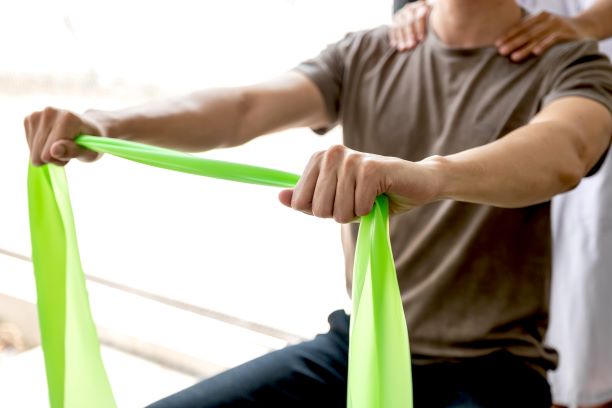About half of people who suffer a shoulder dislocation will have a second dislocation within 2 years. Several types of surgery are proven to reduce future dislocations. But not everyone needs surgery after a shoulder dislocation. Special rehabilitation exercises are proven to improve pain and function after a shoulder dislocation. This article highlights recent research findings that help us identify who would benefit most from surgery.
Who is at Risk for a Second Shoulder Dislocation?
A 2015 study published in the British Journal of Sports Medicine investigated the risk factors that predict recurrent shoulder dislocations. Specifically researchers looked at adults 1 or more years after a shoulder dislocation.
Three important risk factors for future dislocations were identified.
- Men are 3.2 times more likely to dislocate their shoulder a 2nd time
- People 40 years and younger are 13.5 times more likely
- People with “loose joints” are 2.7 times more likely
So, younger more active males with “loose joints” are most at risk for re-injuring their shoulder. If this is you, it would be best to visit an orthopedic surgeon. You are at high risk for re-dislocating your shoulder. If you are older than 40 and more “stiff-jointed” then stick with rehab for at least 3 to 6 months before considering surgery.
Rehab after Surgery for a Shoulder Dislocation
Immediately after surgery, your shoulder is immobilized in a sling. The length of time depends on several factors. This includes your age, activity levels, and the type of surgery done. In general, expect to be in a sling anywhere from 1 to 5 weeks. Your surgeon and physical therapist will determine when it is best to lose your sling.
In most cases, it is safe and recommended you begin range of motion and strengthening exercises within 1 week from surgery. However, the specific exercises prescribed depends on the type of surgery done and the extent of your injuries. The exercises included in this article are examples of what we commonly prescribe.
Controlled Range of Motion Exercises
It is important to protect your repaired ligaments and joint early after surgery. In most cases, the front part of your shoulder joint is repaired. It is important to protect the repair for the first 4 to 6 weeks. However, controlled movement into safe ranges is safe and encouraged immediately after surgery.
This means partial range of motion exercises involving some shoulder rotation and flexion. Flexion exercises are limited to about 50% of your normal range for the first 2 weeks or so. Then you are gradually progressed back to full overhead range of motion. Expect full flexion range of motion by 6 to 8 weeks after surgery.
Your shoulder external rotation range of motion will be progressed more slowly. This movement directly stresses your repair. For the first 4 weeks keep your elbow close to your side when externally rotating away from your body. Your therapist will instruct you how far to move during each exercise. Go easy and don’t expect full external rotation motion until about 8 to 10 weeks after surgery.
Early Strengthening Exercises
During your first week of rehab you will be performing light pain free isometric exercises. Manual resistance exercises with your therapist is a great option. You will also perform pain free rotator cuff isometrics at home. Within 4 weeks after surgery, you will start light band exercises for your rotator cuff. Initially, your therapist may restrict your range of motion during these exercises.
Your scapula provides the base for your shoulder and arm to move. Your base must be stable in order for your shoulder to be stable (and not dislocate). Scapula muscle retraining exercises begin immediately after surgery. Early emphasis is placed on strengthening your serratus anterior, middle trapezius, and lower trapezius.
Your rotator cuff muscles function to keep the ball of your shoulder joint in the socket. You want your rotator cuff to be extra strong to reduce your risk of dislocating your shoulder again. During the first 3 months of your rehab, we encourage band and light dumbbell exercises.
For the Best Results Start Your Rehab Early
After shoulder stabilization surgery, your risk for another dislocation is significantly less. Also, greater than 90% of people undergoing surgery are able to return to sports. However, it is a long road back. Depending on your sport, it may take 6 to 12 months to return.
Your post-surgery rehab is a key factor in you achieving the best outcome after surgery. To avoid a stiff shoulder and prolonged weakness, start your rehab early. The physical therapists at BSR have been rehabbing the people of Southern Ocean County since 2007. Call us and schedule your initial visit to get started.


